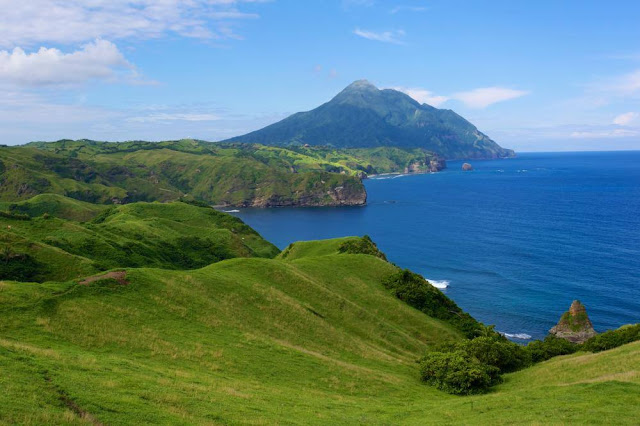Batanes
Batanes is an archipelago province in the Philippines
situated in the Cagayan Valley region. It is the northernmost province in the
country, and also the smallest.
Batanes is an overwhelming combination of majestic,
imposing landscapes and quaint lifestyles. The cliffs are larger than life, the
hills seem to roll on forever; the houses tend to be small and the Ivatans —
the natives of Batanes — are a close-knit, (mostly) friendly bunch.
The only thing you need to do is to make the most out of
your trip to this UNESCO World Heritage nominee. So these are some of it, if
not, the best spots that you should not miss.
Mahayaw
Arch - in Sabtang, these are naturally made stone arch by time which
is heavily photographed, it become icon and symbolic of the island. Sometimes they called it as "Nakabuang", "Mahayaw"
or just simply "Ahaw". This carved arch stone was formed
by geologic forces together with the sea. The arch also serves as a
cooling shade from the scorching heat of the sun.
Earth
and art come together at Fundacion Pacita to create a most
unforgettable and picturesque stay in Basco, Batanes, Philippines. Set atop a
lush hill and caught between the mountain, sea, and sky, the hotel offers the
best spot from which to view the scenic landscape and the cultural and
aesthetic heritage of the Ivatan people.
Pacita Abad is one of the most famous
Ivatans, being an internationally-acclaimed painter who brought her art all
over the world and even painted a bridge in Singapore before dying of cancer.
She also belongs to the powerful Abad clan, a family of Batanes governors and
congressmen (several streets are named after them).
Fundacion Pacita in Basco, once her home and studio, is now a premier
hotel, the proceeds of which go to her foundation for young Ivatan artists. The
young artists of her foundation painted the ceiling of Mt Carmel church in
Basco.
Barangay Savidug offers a
look at the type of medieval concrete houses the inhabitants of the island
lived in during the Spanish era. The sides of the houses facing North have no
windows, as typhoons typically come from the North.
Valugan Boulder Beach – another favorite spot for tourists and photographers
alike, the beach is unique in such a way that it has no sand, instead the beach
is surrounded by boulders of igneous rocks said to be spewed by Mt. Iraya long
ago when it was geologically active. Swimming is impossible here as you can
easily get smashed by the crashing waves and big boulders of rounded stones at
the beach. This is frequented by photographers who wanted to do sunrise shoot
amidst the fantastic backdrop.
Light House. Nowhere
else in the Philippines will you find so many lighthouses. There are recently
constructed ones, such as the Basco lighthouse built in the 2000s visited for
its spectacular view of the sea and the restaurant beside it. There
are two lighthouses in Sabtang, the new one built right beside the sea and the
first one, built during Spanish colonial times, a tiny stone structure standing
far inland from the shore because when it had been built, no other structure
rose above it.
Diura Fishing Village – A
tiny fishing village facing the Pacific Ocean around three kilometers east of
the town of Mahatao. Every year, around mid-March, this is where local
fishermen perform the kapayvanuvanua,
literally means “cleaning of the shore” ritual to signify the start of the
fishing season. The ritual involves a shaman sacrificing a pig then interpret
its liver looking for good omen and good catch.
This tiny village by the
Pacific is home to Ivatan fisher folks and offers a refugeto those who just
want to experience rural, seaside living in Batanes. Not far from the village,
a short hike will take you to the Fountain of Youth, which is actually a
freshwater spring that the residents have diverted into a catchment and sits in
front the sea.

Marlboro Country/ Racuh A Payaman –
get your “The Sound of Music” game on and head to Uyugan to check one of the
popular place for tourists to marvel the scenery and for livestock to graze at.
Seriously, when you reach the rolling hills of Uyugan you will fight the urge
to either 1. do a selfie 2. take a jump shot 3. sing Julie Andrews “The Hills
are Alive” or do all of them! Marvel the spectacular panorama of hills and
hedgerows and slopes and mountains and sea as you listen to the gentle song of
the wind. The image in your head surely will linger for days, months, even
years to come. One interesting fact: Each family can only have up to ten cows
to freely roam in the pasture. A limit is imposed to prevent overgrazing. In
return for use of the land, family members of the livestock owners must help
out in community activities such as building houses, maintaining the hedgerows
around the land and other cooperative works.
















